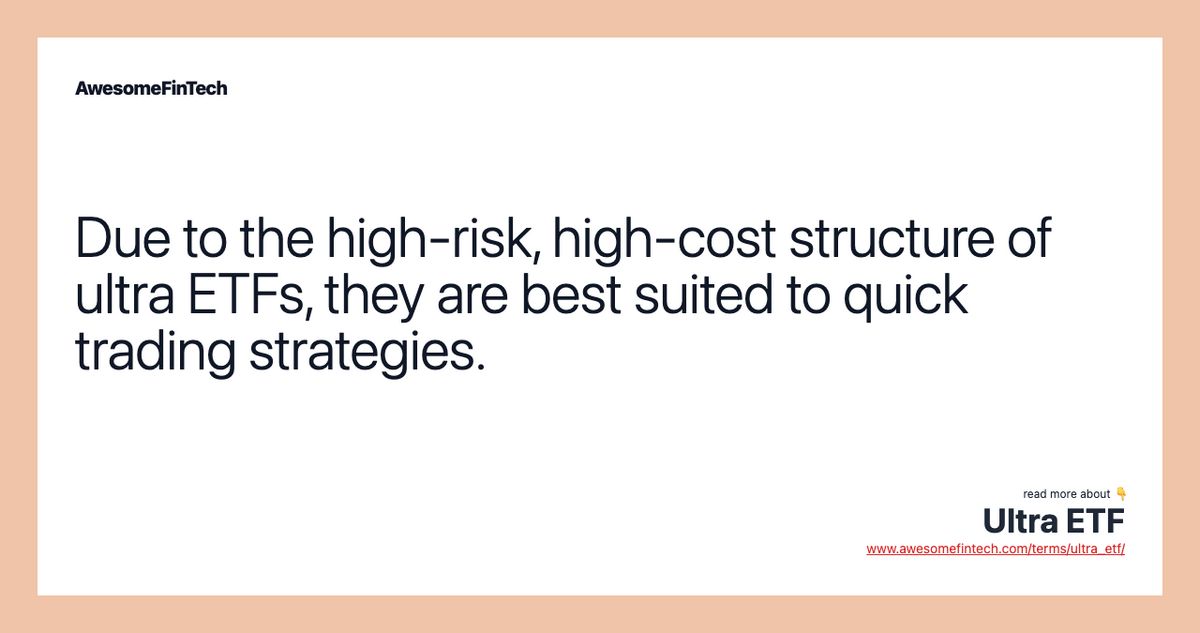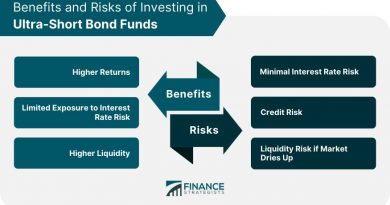Ultra ETF What It Means Benefits Limitations

Ultra ETF: What It Means, Benefits, Limitations
Contents
- 1 Ultra ETF: What It Means, Benefits, Limitations
- 1.1 What Is an Ultra ETF?
- 1.2 Understanding an Ultra ETF
- 1.3 How Ultra ETFs Achieve Leverage
- 1.4 Benefits of an Ultra ETF
- 1.5 Limitations of an Ultra ETF
- 1.6 Special Considerations
- 1.7 What Is the Primary Goal of Ultra ETFs?
- 1.8 What Types of Assets or Indexes Do Ultra ETFs Typically Track?
- 1.9 Are There Alternatives to Ultra ETFs for Achieving Leveraged Exposure in the Market?
- 1.10 The Bottom Line
Ultra ETF: What It Means, Benefits, Limitations
What Is an Ultra ETF?
An ultra ETF is an exchange-traded fund (ETF) that employs leverage to amplify the return of a benchmark. Ultra ETFs include various ETFs with underlying benchmarks ranging from broad market indexes like the S&P 500 and Russell 2000, to specific sectors such as technology, healthcare, and basic materials. Ultra ETFs are also known as leveraged ETFs or geared funds.
Key Takeaways
- An ultra ETF uses leverage to amplify the return of a benchmark.
- They employ financial derivatives and debt to increase the impact of price movements, offering double, triple, or more the long or short performance of an underlying index.
- Due to their high-risk and high-cost structure, ultra ETFs are best suited for quick trading strategies.
Understanding an Ultra ETF
ETFs are funds that invest in a basket of securities from the index they track. They aim to achieve the same returns as their benchmark by replicating its holdings, allowing investors to mimic the performance of the broader equity market or gain exposure to a specific sector or trend.
A traditional ETF usually tracks the securities in its underlying index on a one-to-one basis. However, ultra ETFs seek to be more aggressive. These securities use financial derivatives and debt to amplify returns, offering double, triple, or more the long or short performance of an underlying index.
Leveraging is an investing strategy that involves using borrowed funds to buy options and futures and increase the impact of price movements.
Increased daily volatility is both the biggest benefit and greatest danger of ultra ETFs. They are best suited for short-term investing or quick trading to maximize a bet in the market. Due to their high-risk and high-cost structure, ultra ETFs are rarely used as long-term investments.
According to the prospectuses for these funds, ultra ETFs may not achieve double or more the return of the benchmark during flat markets. Long-term returns may also diverge from the desired performance target. The only aim of ultra ETFs is to amplify the daily return—a goal they have succeeded in fairly accurately in the short time they can be analyzed.
$18.9 billion
The total assets of the ProShares UltraPro QQQ, which offers 3x leverage. As of December 2023, it is the largest leveraged ETF in the U.S. market, according to VettaFi.
How Ultra ETFs Achieve Leverage
Ultra ETFs can achieve leverage in a few ways. The strategies below amplify the potential returns of the underlying index or asset class.
- Use of Derivatives Contracts: Ultra ETFs use financial derivatives such as futures contracts to gain exposure to the underlying index or asset. These derivatives allow controlling a larger position in the underlying asset without holding the actual assets.
- Use of Borrowed Capital: The ETF may borrow money to increase its exposure. This borrowed capital is used to purchase additional assets or derivatives contracts, magnifying the fund’s potential returns.
- Act of Frequent Rebalancing: To maintain the desired level of leverage, ultra ETFs usually require daily or periodic rebalancing. This means buying or selling assets and derivatives every day to reset the leverage level.
- Effect of Compounding: Due to daily or periodic rebalancing, the returns of ultra ETFs are not a simple multiple of the underlying index’s returns. The compounding effect can lead to a significant deviation from the expected multiple over time.
Benefits of an Ultra ETF
If an investor believes the S&P 500 is about to rise, they may want to explore ways to make as much money as possible from this conviction. An ultra ETF can cater to those needs without incurring the additional expenses and stress of trading on margin.
Ultra ETFs can be beneficial to tactical investors who have limited capital or allocation space within a diversified portfolio. They can invest 5 percent of their portfolios into an ultra ETF and gain closer to 10 percent exposure due to the leveraged returns.
Limitations of an Ultra ETF
Leverage is a double-edged sword: It can lead to significant gains, as well as significant losses. The use of leverage magnifies not only the return potential of these ETFs but also the standard deviation, making these investments riskier than non-leveraged ETFs targeting the same index or investment style.
Ultra ETFs represent a small portion of the total ETF universe, accounting for approximately $73.63 billion, or 4.30 percent of the $1.71 trillion total ETF market as of December 2023.
Investors looking for long-term, buy and hold investments should avoid ultra ETFs. Daily rebalancing and compounding, combined with leverage, cause investment results to significantly diverge over time from expectations. Furthermore, ultra ETFs have higher expense ratios than standard ETFs.
Special Considerations
Ultra ETFs also enable investors to amplify their returns when shorting, or betting against, an underlying index. Inverse ultra ETFs, or ultra shorts, use leverage to make extra money when a market declines in value.
Investing in ultra ETFs may have greater tax implications. Ultra ETFs buy and sell their underlying securities frequently, resulting in capital gain distributions. Holding ultra ETFs in tax-advantaged accounts such as IRAs is possible but comes with higher volatility and risk.
What Is the Primary Goal of Ultra ETFs?
The primary goal of ultra ETFs is to provide traders with the opportunity to capitalize on short-term market movements and amplify potential gains. These ETFs are typically used for tactical trading and not for long-term investment strategies.
What Types of Assets or Indexes Do Ultra ETFs Typically Track?
Ultra ETFs can track a wide range of assets and indexes, including equity indices, commodities, and fixed-income instruments. Some popular ultra ETFs are linked to major stock market indices such as the S&P 500, gold, or oil.
Are There Alternatives to Ultra ETFs for Achieving Leveraged Exposure in the Market?
Yes, alternatives to ultra ETFs for achieving leveraged exposure include options contracts, leveraged mutual funds, and leveraged index funds.
The Bottom Line
Ultra ETFs, also known as leveraged ETFs, are specialized funds designed to provide amplified exposure to an underlying index or asset class. They achieve this leverage through the use of financial derivatives, aiming for double or triple the daily returns of the underlying benchmark. Note that ultra ETFs are generally more suitable for short-term investments and not recommended for long-term hold strategies.



